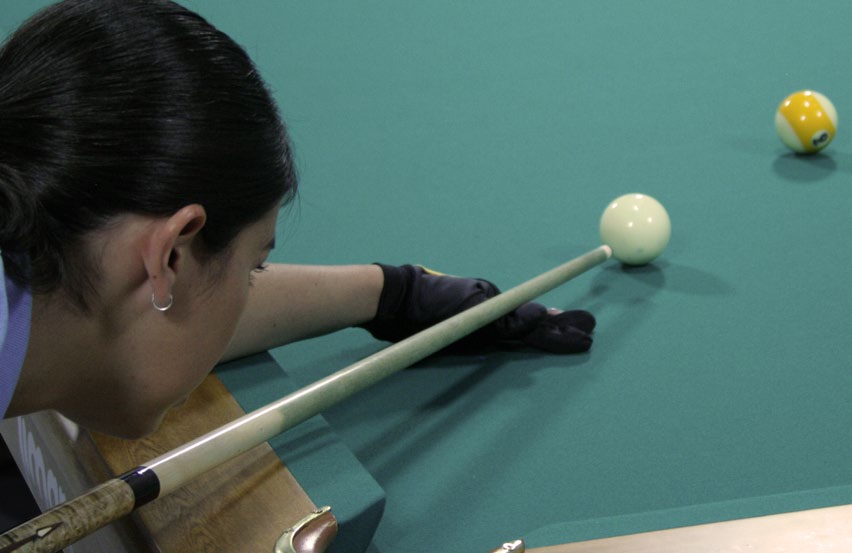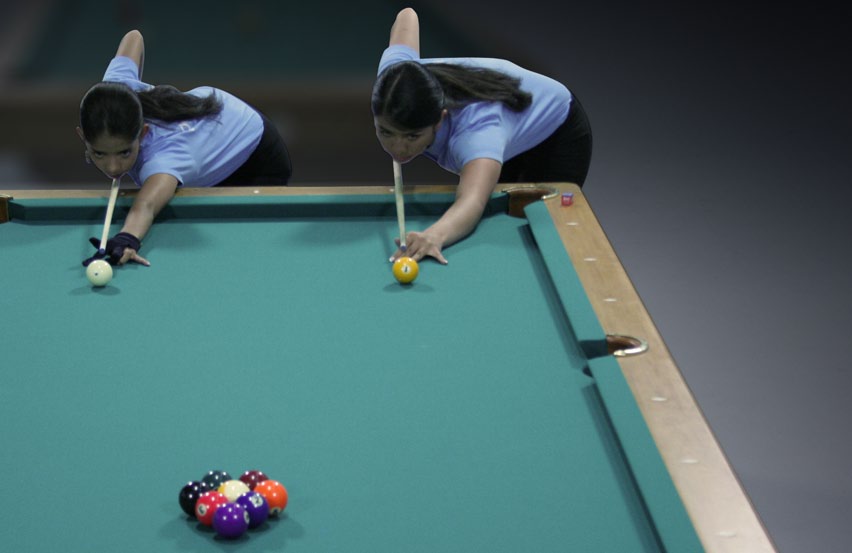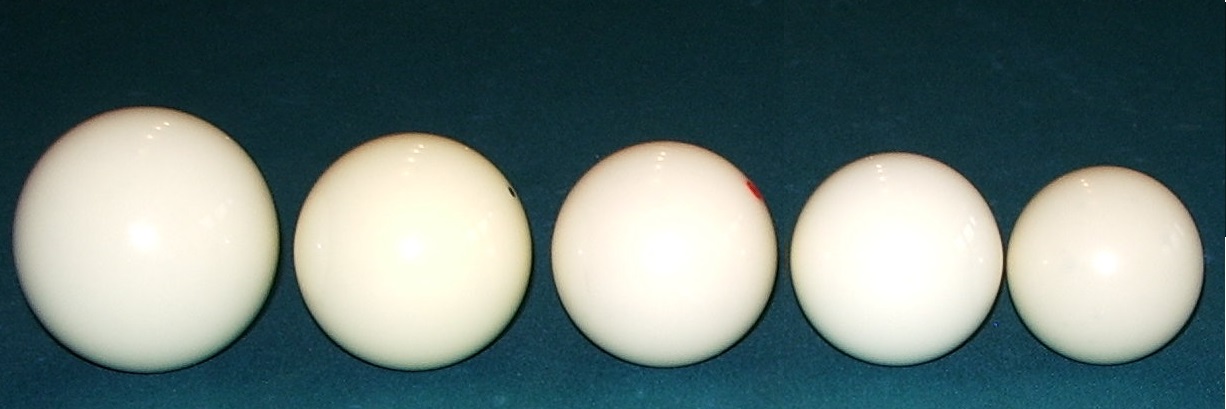|
Rack (billiards)
A rack (sometimes called a triangle) is a piece of equipment that is used to place billiard balls in their starting positions at the beginning of a pocket billiards game. ''Rack'' may also be used as a verb to describe the act of setting billiard balls in their starting positions (e.g. "to rack the balls"), or as a noun to describe a set of balls that are in their starting positions (e.g. "a rack of balls", more often called a ''pack'' or a ''pyramid'' in British English). Traditional racks are in the form of triangular frames, usually made from wood, plastic or metal. A modern variation, called a ''template rack'', is made from a thin material (usually 0.14 mm or less) that contains precision cut-outs to hold the balls in place. Purported benefits of template racks include a more consistent racking, and their popularity has warranted specific inclusion in profession rules. Unlike traditional racks, template racks are left on the table during the break shot and removed at the ... [...More Info...] [...Related Items...] OR: [Wikipedia] [Google] [Baidu] |
Billiards Rack
Cue sports are a wide variety of Game of skill, games of skill played with a cue stick, cue, which is used to strike billiard balls and thereby cause them to move around a Baize, cloth-covered billiards table, table bounded by elastic bumpers known as . There are three major subdivisions of games within cue sports: *Carom billiards, played on tables without , typically 10 feet in length, including straight rail, balkline, one-cushion carom, three-cushion billiards, artistic billiards, and Four-ball billiards, four-ball *Pool (cue sports), Pool, played on six-pocket tables of 7-, 8-, 9-, or 10-foot length, including among others eight-ball (the world's most widely played cue sport), nine-ball (the dominant professional game), ten-ball, straight pool (the formerly dominant pro game), one-pocket, and bank pool *Snooker, English billiards, and Russian pyramid, played on a large, six-pocket table (dimensions just under 12 ft by 6 ft), all of which are classified separately ... [...More Info...] [...Related Items...] OR: [Wikipedia] [Google] [Baidu] |
Snooker
Snooker (pronounced , ) is a cue sports, cue sport played on a Billiard table#Snooker and English billiards tables, rectangular table covered with a green cloth called baize, with six Billiard table#Pockets 2, pockets, one at each corner and one in the middle of each long side. First played by British Army officers stationed in India in the second half of the 19th century, the game is played with twenty-two balls, comprising a , fifteen red balls, and six other balls—a yellow, green, brown, blue, pink, and black—collectively called the colours. Using a cue stick, the individual players or teams take turns to strike the white to other balls in a predefined sequence, accumulating points for each successful pot and for each time the opposing player or team commits a . An individual of snooker is won by the player who has scored the most points. A snooker ends when a player reaches a predetermined number of frames. Snooker gained its identity in 1875 when army officer Nevil ... [...More Info...] [...Related Items...] OR: [Wikipedia] [Google] [Baidu] |
Cue Stick
A cue stick (or simply cue, more specifically billiards cue, pool cue, or snooker cue) is an item of sporting equipment essential to the games of pool, snooker and carom billiards. It is used to strike a ball, usually the . Cues are tapered sticks, typically about 57–59 inches (about 1.5 m) long and usually between 16 and 21 ounces (450–600 g), with professionals gravitating toward a 19-ounce (540 g) average. Cues for carom tend toward the shorter range, though cue length is primarily a factor of player height and arm length. Most cues are made of wood, but occasionally the wood is covered or bonded with other materials including graphite, carbon fiber or fiberglass. An obsolete term for a cue, used from the 16th to early 19th centuries, is billiard stick. History The forerunner of the cue was the , an implement similar to a light-weight golf club, with a foot that was generally used to shove rather than strike the cue ball. When the ball was ag ... [...More Info...] [...Related Items...] OR: [Wikipedia] [Google] [Baidu] |
Snooker
Snooker (pronounced , ) is a cue sports, cue sport played on a Billiard table#Snooker and English billiards tables, rectangular table covered with a green cloth called baize, with six Billiard table#Pockets 2, pockets, one at each corner and one in the middle of each long side. First played by British Army officers stationed in India in the second half of the 19th century, the game is played with twenty-two balls, comprising a , fifteen red balls, and six other balls—a yellow, green, brown, blue, pink, and black—collectively called the colours. Using a cue stick, the individual players or teams take turns to strike the white to other balls in a predefined sequence, accumulating points for each successful pot and for each time the opposing player or team commits a . An individual of snooker is won by the player who has scored the most points. A snooker ends when a player reaches a predetermined number of frames. Snooker gained its identity in 1875 when army officer Nevil ... [...More Info...] [...Related Items...] OR: [Wikipedia] [Google] [Baidu] |
9ball
Nine-ball (sometimes written 9-ball) is a discipline of the cue sport pool. The game's origins are traceable to the 1920s in the United States. It is played on a rectangular billiard table with at each of the four corners and in the middle of each long side. Using a cue stick, players must strike the white cue ball to nine colored billiard balls, hitting them in ascending numerical order. An individual game (or ) is won by the player pocketing the . Matches are usually played as a to a set number of racks, with the player who reaches the set number winning the match. The game is currently governed by the World Pool-Billiard Association (WPA), with multiple regional tours. The most prestigious nine-ball tournaments are the WPA World Nine-ball Championship and the U.S. Open Nine-ball Championships. Notable 9-Ball players in the game include Luther Lassiter, Buddy Hall, Earl Strickland and Shane Van Boening. The game is often associated with hustling and gambling, with tourname ... [...More Info...] [...Related Items...] OR: [Wikipedia] [Google] [Baidu] |
Billiard Rack
Billiard or billiards may refer to: Games * A , a type of shot in cue sports ''(see below)'' * Billiards: cue sports in general; the term "billiards" by itself is also sometimes used to refer to any of the following more specifically: ** Carom billiards (also known as French billiards), games in general (a chiefly non-British usage) ** Three-cushion billiards, even more specifically, the most popular form of carom billiards worldwide ** The specific game of English billiards (a chiefly British, Irish and Australian usage) ** Pool (cue sports) (pocket billiards) games, such as eight-ball and nine-ball, in general (a chiefly colloquial North American usage) * See the list of cue sports for various other games with "billiards" in their names; also more specifically: ** Pin billiards, a fairly large number of billiard games that use a pin, or a set of "pins", or "skittles" ** Bar billiards, a game combining elements of bagatelle and English billiards * Electric billiards, an obsolete ... [...More Info...] [...Related Items...] OR: [Wikipedia] [Google] [Baidu] |
Nine-ball
Nine-ball (sometimes written 9-ball) is a discipline of the cue sport pool. The game's origins are traceable to the 1920s in the United States. It is played on a rectangular billiard table with at each of the four corners and in the middle of each long side. Using a cue stick, players must strike the white cue ball to nine colored billiard balls, hitting them in ascending numerical order. An individual game (or ) is won by the player pocketing the . Matches are usually played as a to a set number of racks, with the player who reaches the set number winning the match. The game is currently governed by the World Pool-Billiard Association (WPA), with multiple regional tours. The most prestigious nine-ball tournaments are the WPA World Nine-ball Championship and the U.S. Open Nine-ball Championships. Notable 9-Ball players in the game include Luther Lassiter, Buddy Hall, Earl Strickland and Shane Van Boening. The game is often associated with hustling and gambling, with tournament ... [...More Info...] [...Related Items...] OR: [Wikipedia] [Google] [Baidu] |
Bank Pool
Bank pool is a pool game that has as its most fundamental requirement that all scoring shots in the game must be made by a called ball off a and into a called pocket. While the game has multiple variations, the predominant version through much of its history was played with a full fifteen-ball , of which the winning player was required to legally pocket eight balls. A shortened version of the game using nine balls of which the players must legally pocket five for the win, often called "nine-ball banks," gained popularity in the 1990s and 2000s and is the subject of international professional competition and televised matches. Rules Aim The object of the game is to be the first player to five balls in any order (or eight balls, when played with a full rack). Rack The balls are racked in nine-ball formation (or eight-ball formation if using a full rack), but in no particular order. On the break shot, at least four balls must hit the rails else it is an illegal break. Any bal ... [...More Info...] [...Related Items...] OR: [Wikipedia] [Google] [Baidu] |
Billiard Ball
A billiard ball is a small, hard ball used in cue sports, such as carom billiards, pool, and snooker. The number, type, diameter, color, and pattern of the balls differ depending upon the specific game being played. Various particular ball properties such as hardness, friction coefficient, and resilience are important to accuracy. History Early balls were made of various materials, including wood and clay (the latter remaining in use well into the 20th century). Although affordable ox-bone balls were in common use in Europe, elephant ivory was favored since at least 1627 until the early 20th century; the earliest known written reference to ivory billiard balls is in the 1588 inventory of the Duke of Norfolk. Dyed and numbered balls appeared around the early 1770s. By the mid-19th century, elephants were being slaughtered for their ivory at an alarming rate, just to keep up with the demand for high-end billiard balls – no more than eight balls could be made from a single ... [...More Info...] [...Related Items...] OR: [Wikipedia] [Google] [Baidu] |
One-pocket
One-pocket is a pool game. Unlike other games played on a pool table where any can be used to score , only one pocket for each player is used in this game. The object of the game is to score points. A point is made when a player pockets any object ball into their designated pocket. The winner is the first to score an agreed-upon number of points (usually 8). One-pocket is similar to straight pool in that a player can shoot at any object ball regardless of its color or number. Unlike straight pool, however, a shooter does not need to call their shots. Penalties for a are the loss of 1 point, re- a previously pocketed ball if possible, and in the case of a , the incoming player gets behind the . Three consecutive fouls is a loss of game. If a player pockets an object ball in a pocket other than those at the top of the table, their turn ends and that object ball is respotted, unless an object ball is also potted into their designated pocket on the same shot. If the player pockets ... [...More Info...] [...Related Items...] OR: [Wikipedia] [Google] [Baidu] |
Straight Pool
Straight pool, which is also called 14.1 continuous and 14.1 rack, is a cue sport in which two competing players attempt to as many billiard balls as possible without playing a . The game was the primary version of pool played in professional competition until it was superseded by faster-playing games like nine-ball and eight-ball in the 1980s. In straight pool, the player may and attempt to pocket any object ball on the table regardless of its number or color until only one object ball and the remain, at which point the other fourteen balls are re-racked. At this point, play resumes with the objective of pocketing the remaining ball in a manner that causes the cue ball to carom into the rack, spreading out the balls and allowing the player to continue the run. The goal is to reach a set number of points that is determined by agreement before the game begins; traditionally 100 points is needed for a win, though professional matches may be higher. One point is scored by poc ... [...More Info...] [...Related Items...] OR: [Wikipedia] [Google] [Baidu] |



.jpg)



_LCCN2014682795_(cropped).jpg)